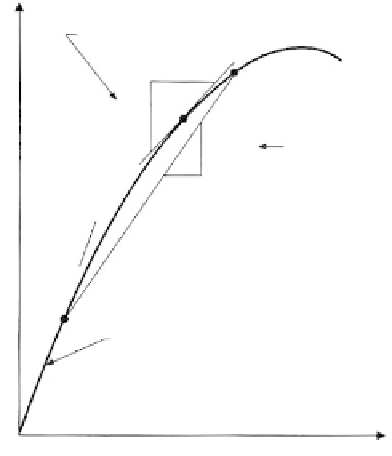Environmental Engineering Reference
In-Depth Information
Tangent modulus E
t
1
d
σ
d
ε
Secant
modulus E
se
∆σ
∆ε
1
Initial tangent modulus E
i
FIGURE 3.70
Forms of moduli from the stress-strain curve.
Strain
ε
compression of quartz grains may occur. In most cases, the greater portion of compression
is essentially immediate upon the application of load.
Expansion
An increase in volume occurs as a result of reduction in applied stress, increase in mois-
ture content, or mineralogical changes in certain soil and rock materials (see
Section 3.5.4
and 10.6).
3.5.3
Rock Deformation Measurements
Methods Summarized
Laboratory Testing
Intact specimens are statically tested in the laboratory in the triaxial and unconfined com-
pression apparatus; dynamic properties are measured with the resonant column device or
by ultrasonic testing (ASTM 2845). A summary of parameters measured, apparatus
description, and test performance for intact rock specimens is given in
Table 3.28
.
The data
are normally used for correlations with
in situ
test data.
In Situ Testing
In situ
testing provides the most reliable data on the deformation characteristics of rock
masses because of the necessity of accounting for the effects of mass defects from discon-
tinuities and decomposition.
The determination of moduli
in situ
requires that the deformation and the stress
producing it are measurable and that an analytical method of describing the geometry of
the stress deformation relationship is available. Analytical methods are governed by the
testing method. Modulus is the ratio of stress to strain, and since strain is the change in
length per total length, the deflection that is measured during
in situ
testing must be
related to the depth of the stressed zone to determine strain. The depth of the stressed zone
may be determined by instrumentation (see
Chapter 4),
or the Boussinesq equations may




